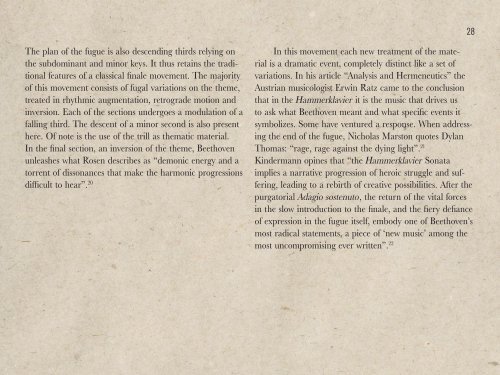LATE BEETHOVEN LATE BEETHOVEN - Luisa Guembes-Buchanan
LATE BEETHOVEN LATE BEETHOVEN - Luisa Guembes-Buchanan
LATE BEETHOVEN LATE BEETHOVEN - Luisa Guembes-Buchanan
Erfolgreiche ePaper selbst erstellen
Machen Sie aus Ihren PDF Publikationen ein blätterbares Flipbook mit unserer einzigartigen Google optimierten e-Paper Software.
The plan of the fugue is also descending thirds relying on<br />
the subdominant and minor keys. It thus retains the traditional<br />
features of a classical finale movement. The majority<br />
of this movement consists of fugal variations on the theme,<br />
treated in rhythmic augmentation, retrograde motion and<br />
inversion. Each of the sections undergoes a modulation of a<br />
falling third. The descent of a minor second is also present<br />
here. Of note is the use of the trill as thematic material.<br />
In the final section, an inversion of the theme, Beethoven<br />
unleashes what Rosen describes as “demonic energy and a<br />
torrent of dissonances that make the harmonic progressions<br />
difficult to hear”. 20<br />
In this movement each new treatment of the material<br />
is a dramatic event, completely distinct like a set of<br />
variations. In his article “Analysis and Hermeneutics” the<br />
Austrian musicologist Erwin Ratz came to the conclusion<br />
that in the Hammerklavier it is the music that drives us<br />
to ask what Beethoven meant and what specific events it<br />
symbolizes. Some have ventured a response. When addressing<br />
the end of the fugue, Nicholas Marston quotes Dylan<br />
Thomas: “rage, rage against the dying light”. 21<br />
Kindermann opines that “the Hammerklavier Sonata<br />
implies a narrative progression of heroic struggle and suffering,<br />
leading to a rebirth of creative possibilities. After the<br />
purgatorial Adagio sostenuto, the return of the vital forces<br />
in the slow introduction to the finale, and the fiery defiance<br />
of expression in the fugue itself, embody one of Beethoven’s<br />
most radical statements, a piece of ‘new music’ among the<br />
most uncompromising ever written”. 22<br />
28


